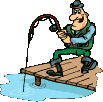Fishing Line
Everyone likes different fishing line.” Cost, durability and action can all be factors in choosing fishing line. As a result, choosing fishing line isn’t as easy it seems.
Choosing Fishing Line
Many of the major decisions about fishing line are made for you by the rod and reel you use. As well, fishing conditions and method eliminate some kinds of line.
Fishing line is personal preference built by experience. Knowing species and size of fish the water conditions and the bottom and help anglers choose an appropriate line. The right line can be the difference between catching fish and “the one that got away” stories.
Click on any banner, link or image. Purchase that item or type your item in the search bar.







 Fishing Line for Light Tackle
Fishing Line for Light Tackle
The lighter the tackle the lighter weight the line. For example, an ultra light rig calls for 2 – 6 lb. test line. This thickness  allows for an adequate supply of line on the spool. As well, this weight line can be cast easily with the light rod. If you tie into a bigger fish, you just need more finesse and playing time.
allows for an adequate supply of line on the spool. As well, this weight line can be cast easily with the light rod. If you tie into a bigger fish, you just need more finesse and playing time.
Fishing Line for Medium Tackle
Medium tackle for bass or walleye fishing would require up to 12 lb. test. However, some anglers prefer heavier line to stack the odds in their favor. Competitions often limit the upper limit of line weight. In expensive, medium weight line easily displays any of its shortcomings as larger fish are played.
Heavier Test for Action Lures
Modern crank banks, diving lures and spinner baits create a huge amount of drag whether trolled or retrieved. Consequently, 15 to 35 lb. test is recommended when using these baits.
Deep Trolling Line
Its possible to troll without extra the extra equipment of a down rigger. Either lead core line or wire line is used. The theory is that the more line out from the boat, the more weight and the deeper the bait. Colored line for trolling helps gauge depth. Both of these lines require trolling rods to sustain the weight and trolling reels to hold the line.
Inexpensive Line will:
- Stretch causing kinking with any slack in cast or retrieval
- Fray and often break when crossing rocks or logs.
- Kink on the spool if nor changed frequently.
- Become brittle and break while playing a fish.
Types of Fishing Line
As a kid I used to favor 6 lb. test line for bass. I would be the 1000 yard spool for $2. Inexpensive monofilament line is still available. Every 4th or 5th cast, the a kink would jump of the spool. I didn’t care. I would just cut the line, retie my leader and cast again.
Which Line?
There are a variety of types of line available.
- Most spinning reels suggest monofilament line. It comes in clear or flourescent.
- Braided works best when bait casting, bottom fishing or fishing near weeds or structures. Braided line is generally stronger than monofilament, but it can wear more quickly moving across structure.
- Lead core line can be metered or colored for depth.
- Steel line can be dark or stainless steel
Take a moment to comment on this page. What is your favorite type of line? Which test do you most often fish?
 class="page-template-default page page-id-1270 page-child parent-pageid-863">
class="page-template-default page page-id-1270 page-child parent-pageid-863">

